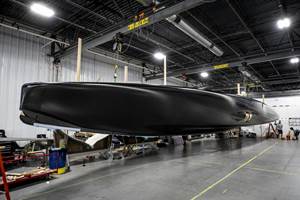RVB insider insights
Experts in reusable vacuum bag technology share insights into bags adapted for autoclave use.
Reusable vacuum bag (RVB) technologies have been around for quite some time, but recently, their utility and, therefore, molder interest in them, has blossomed, particularly among those who produce autoclave-cured composite parts.
“Commercial fabricators and infusion shops were hungry for knowledge about this technology throughout the past decade,” recalls Keith Charles, technical sales manager at Mosites Rubber Co. (Ft. Worth, Texas). He says, “Training is key.” Charles says there have been many lessons learned while fulfilling orders for vacuum infusion customers that are useful for those who autoclave-cure. Among them is the necessity of building a reusable vacuum bag (RVB) directly on a part or part plug to ensure an accurate fit. “If the bag is too big, you can get wrinkles under vacuum. If it’s undersized and not stretched uniformly, and there’s any resin backpressure under the bag, you can get bridging that can lead to resin-rich corners or areas in the part.”
Charles also stresses that the RVB thickness must strike the right balance among longevity, economy and weight. “A bag thickness of 0.060 inch [1.5 mm] can work well for an infusion process, and last for an acceptable number of parts,” he notes, but warns, “If you’re using the bag in a higher temperature autoclave process with epoxy resin, we recommend at least 0.085 inch [2.2 mm] in thickness” to stand up to higher curing heat, autoclave pressure and epoxy resin chemistry.
Torr Technologies Inc. (Auburn, Wash.) uses Mosites sheet silicone, and sheet materials from other suppliers, to make a wide range of seamed bags for customers who make infused, autoclave-cured parts. Torr’s president, Greg Lindstrom, says Torr also sells cured and uncured sheet stock to customers who want to make their own RVBs. In most situations, he recommends using uncured, high-strength or “B-stage” silicone sheet — that is, silicone that is not fully vulcanized to form long-chain polymers. Typically, this material is supplied frozen, with a polyethylene backing in thicknesses of 0.063, 0.085 or 0.125 inch (1.6, 2.2 or 3.175 mm); widths of 54 inches/1,350 mm; and lengths of 200 inches/5m. Before use, it’s thawed to room temperature, cut and laid over a part pattern or form.
“We prep the form with a release,” Lindstrom says.“We actually use Dawn dishwashing soap, wiped on, then toweled off to leave a very thin film. The uncured silicone sheet, which has the consistency of modeling clay, is then laid over,” He explains that to span parts larger than the width of the silicone, the material edge is pressed down against the form and then skived (tapered) with a sharp knife. A second sheet edge, also tapered, is then overlapped against the first edge, and they are pressed together to form a splice. “The tapering helps to ensure consistent bag thickness, so that the seam isn’t too bulky.”
Torr Technologies’ RVBs typically include a metal frame around the perimeter to ensure stability and ease lifting. The frame is bonded to the silicone membrane with a room-temperature vulcanizing (RTV) silicone adhesive. V-shaped extruded silicone edge seals are bonded to the membrane below the frame. Lindstrom says that the seal shape “self-initiates” a good seal under vacuum, ensuring vacuum integrity. He recommends a second rectangular or square extruded shape inboard of the vacuum seal. Lindstrom says this extra strip, trademarked as Interflow (see "Reusable Vacuum Membranes," under "Editor's Picks" at top right) reduces stress on the membrane as it transitions from the frame to the mold surface. Torr adds a similar strip, placed 0.5 inch/12.5 mm inboard of the main vacuum seal, to form a dam that prevents epoxy resin from migrating and attacking the vacuum seal. Not a necessity, B-stage silicone-coated fabric is sometimes integrated into the RVB to stabilize the rubber and increase its hardness or strength. The completed silicone layup is cured in an autoclave at 300°F/149°C for about an hour, then removed from the form and postcured for about four hours. Although the silicone material shrinks slightly (2 to 3 percent) during cure, Lindstrom says the bag’s design takes that into account, resulting in a “perfect” fit. “Curing silicone in this way,” he adds, “ensures a very durable bag ... and many part cycles.”
Related Content
XlynX Materials BondLynx and PlastiLynx for low surface energy PP, PE substrates
Award-winning Xlynx materials use breakthrough “diazirine” technology to boost bond strength up to 950% as adhesives, primers and textile strengtheners.
Read MoreThe making of carbon fiber
A look at the process by which precursor becomes carbon fiber through a careful (and mostly proprietary) manipulation of temperature and tension.
Read MorePRF Composite Materials introduces primer, adhesive films
Novel RFA570 eXpress cure adhesive film and RF Primer are compatible with PRF’s full range of epoxy prepregs formulations.
Read MorePro-Set named official materials supplier for New York Yacht Club American Magic
Competitive sailing team prepares for the 37th America’s Cup beginning in August 2024 with adhesives, resins and laminate testing services for its AC75 monohull construction.
Read MoreRead Next
Reusable vacuum membranes: Coming of age?
Durable custom elastomeric bags cut consumables cost and boost rate production.
Read MoreFrom the CW Archives: The tale of the thermoplastic cryotank
In 2006, guest columnist Bob Hartunian related the story of his efforts two decades prior, while at McDonnell Douglas, to develop a thermoplastic composite crytank for hydrogen storage. He learned a lot of lessons.
Read MoreComposites end markets: Energy (2024)
Composites are used widely in oil/gas, wind and other renewable energy applications. Despite market challenges, growth potential and innovation for composites continue.
Read More














.jpg;maxWidth=300;quality=90)











